Table of Contents
The digital age has ushered in a new era of collaboration, where teams can share ideas, provide feedback, and work together on projects in real-time. This shift towards real-time collaboration has been a game-changer, particularly in the realm of content creation.
It has transformed how content teams ideate, draft, revise, and finalize their work, fostering a more dynamic and efficient creative process.
One platform where this shift is especially evident, and necessary, is WordPress. As one of the most popular content management systems (CMS) globally, WordPress powers over 43% of all websites, making its real-time collaboration capabilities and competencies a pressing need for content teams.
With its extensive usage, the ability to collaborate in real-time directly within the WordPress editor could revolutionize the way teams create content, improving efficiency, quality, and satisfaction.
In this article, we’ll explore the reasons why real-time collaboration is essential for WordPress users and how you can enable it today.
Why Do You Need Real-Time Online Collaboration Tools?
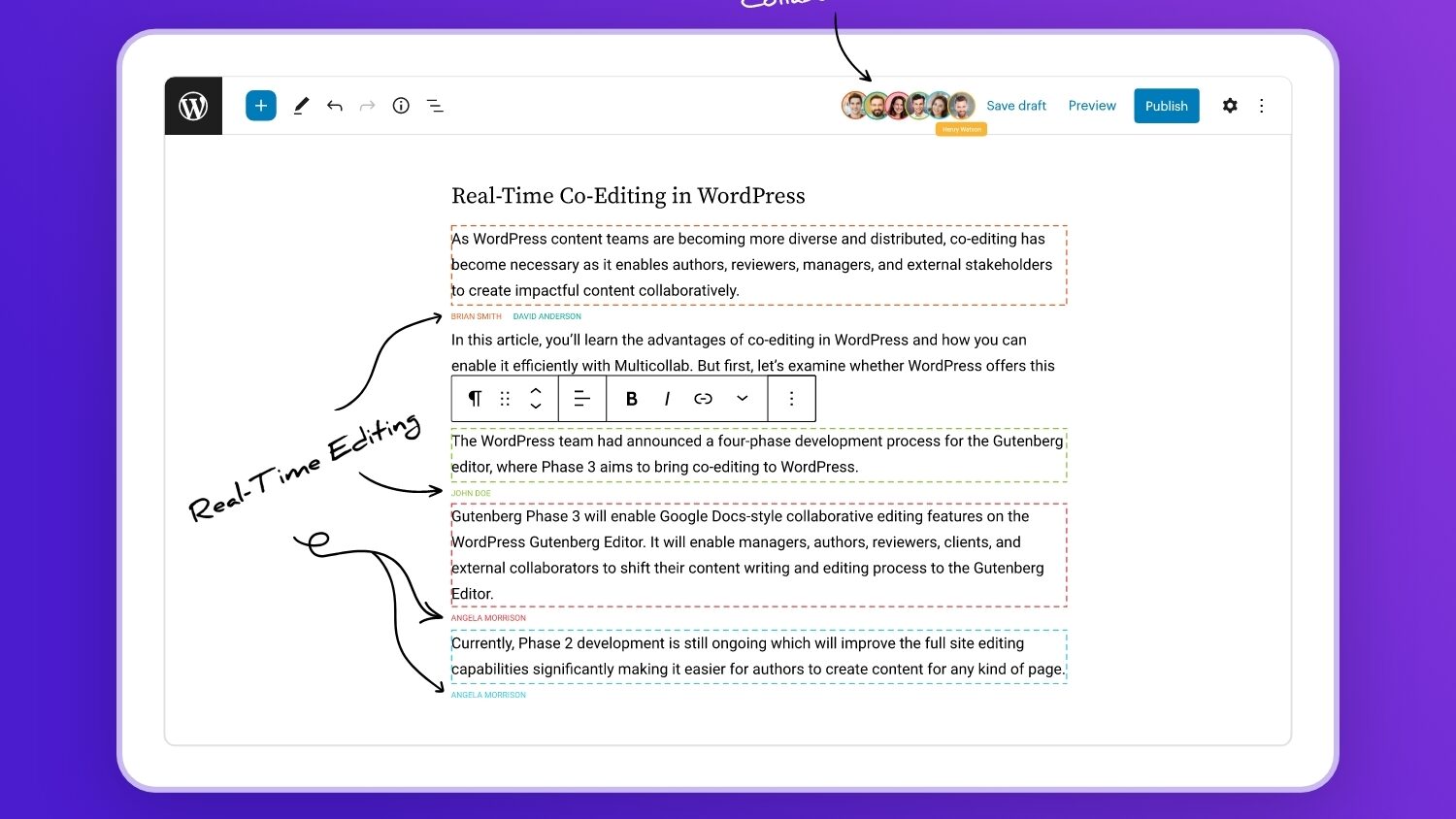
1. Improved Team Communication
Imagine a situation where an author drafts an article and uploads it onto the WordPress editor. With real-time collaboration capabilities, other team members – be it editors, reviewers, or even clients – can access this draft instantly. They can read it, make inline comments, suggest edits, and even make modifications directly in the document.
This instant communication eliminates the need for lengthy email threads or disjointed conversations on third-party platforms, keeping all discussions centralized and contextual.
Another crucial aspect of real-time collaboration is the ability to provide and receive instant feedback. Let’s consider a scenario where a team member is unsure about a particular section of the content or the use of a specific keyword. In traditional workflows, they might need to send an email or message, then wait for a response before proceeding.
However, with real-time collaboration tools, they can simply leave a comment or question right next to the concerning part of the content. Other team members can see this query instantly and provide their inputs, allowing the issue to be resolved quickly and efficiently.
This dynamic nature of communication not only saves time but also ensures that everyone stays on the same page. It encourages open discussion and faster decision-making and ultimately leads to a smoother, more cohesive content creation process.
2. Streamlined Content Production Workflow
One of the most notable advantages of real-time collaboration in WordPress is the potential to streamline the content production workflow.
Without real-time communication, an article might be written, edited, proofread, and reviewed multiple times before it’s ready for publishing. Each of these stages often involves a separate document version, leading to confusion, versioning conflicts, and a delay in content production.
This issue can be largely mitigated with real-time collaboration. Team members can work simultaneously on the same document, making edits, suggestions, and revisions in real time. The need for multiple document versions is eliminated, as all changes are tracked and visible to everyone involved.
This reduces the time and effort required for drafting and reviewing content, and it also enhances the quality of the output as the process becomes more cohesive and less fragmented.
Another benefit of real-time collaboration in WordPress is the reduction of time spent on transferring content between tools.
Typically, content teams might use third-party editing tools like Google Docs or Microsoft Word for drafting and reviewing content.
Once the content is ready, it’s transferred to the WordPress Gutenberg editor for final formatting and publishing. This back-and-forth transfer of content can be time-consuming and challenging, especially considering that different editors process text differently, which often leads to formatting issues.
For instance, a publisher might spend hours fixing the formatting of a post because the Gutenberg editor processed the transferred text differently than Google Docs. This not only slows down the content production process but also affects the productivity of the team.
However, with WordPress real-time collaboration tools like Multicollab, the entire content production process – from drafting to publishing – can be carried out directly in the WordPress Gutenberg editor.
This eliminates the need for transferring content between tools, saving time, reducing formatting issues, and allowing content teams to focus more on creating high-quality content. Try it now!
3. Enhanced Content Quality
With real-time collaboration, as a writer drafts the article, an editor or a subject matter expert can concurrently review the content to point out any inaccuracies or suggest improvements on the spot, allowing the writer to make immediate corrections.
This swift identification and resolution of issues not only save time but also enhance the accuracy and overall quality of the content.
Moreover, having multiple perspectives during the content creation process is another benefit you can look forward to with real-time collaboration that enhances your content quality. For example, during the ideation phase, brainstorming in real-time can lead to a wider array of topic ideas, thanks to the diverse viewpoints of the team members.
Similarly, during drafting, a writer might have a particular narrative style, but a co-worker could suggest an alternative approach that might resonate better with the target audience.
In essence, real-time collaboration brings together the collective wisdom and expertise of the team, leading to more robust, comprehensive, and high-quality content that aligns with the audience’s needs and expectations.
4. Increased Team Satisfaction and Productivity
Let’s consider a scenario: A WordPress content team is working on an extensive project – an eBook on digital marketing trends. The team includes a content writer, an editor, a graphic designer, and a project manager.
In a traditional workflow, the content writer would first draft the entire eBook, then send it to the editor for review. Upon completion of the editorial review, the content would be passed to the graphic designer for layout and design. Once the design is complete, the project manager would review the final product before publication.
Throughout this process, there’s ample room for miscommunication and misunderstandings.
What if the writer misinterprets the project brief? What if the editor doesn’t understand the writer’s intent behind a particular section? What if the graphic designer isn’t clear about the placement of images or infographics?
These disconnects can lead to numerous revisions, causing delays, frustration, and a decrease in team morale.
Now, imagine the same project executed with real-time collaboration. The content writer drafts a section and immediately receives feedback from the editor. The graphic designer can simultaneously suggest where to insert visuals, all while the project manager oversees the progress in real-time.
This real-time interaction and immediate feedback loop eliminates misunderstandings, reduces the need for revisions, and fosters a more harmonious and satisfying work environment.
Moreover, it allows teams to be more flexible and responsive. If there’s a sudden change in project requirements or a last-minute content update, the team can promptly adapt and make necessary adjustments, thanks to the open and ongoing communication enabled by real-time collaboration.
Collaborate in Real-Time on WordPress Gutenberg Editor
Multicollab is a WordPress plugin that allows you to leverage all the aforementioned benefits by enabling Google Docs-style content collaboration and co-editing features in the Gutenberg Editor. Apart from decreasing your dependency on third-party content collaboration tools, it will also make your review process faster as you can exchange feedback on multimedia and dynamic content just like you do on texts.
- Suggestion Mode: Enables tracking of the content creation process by adding inline comments for review by others.
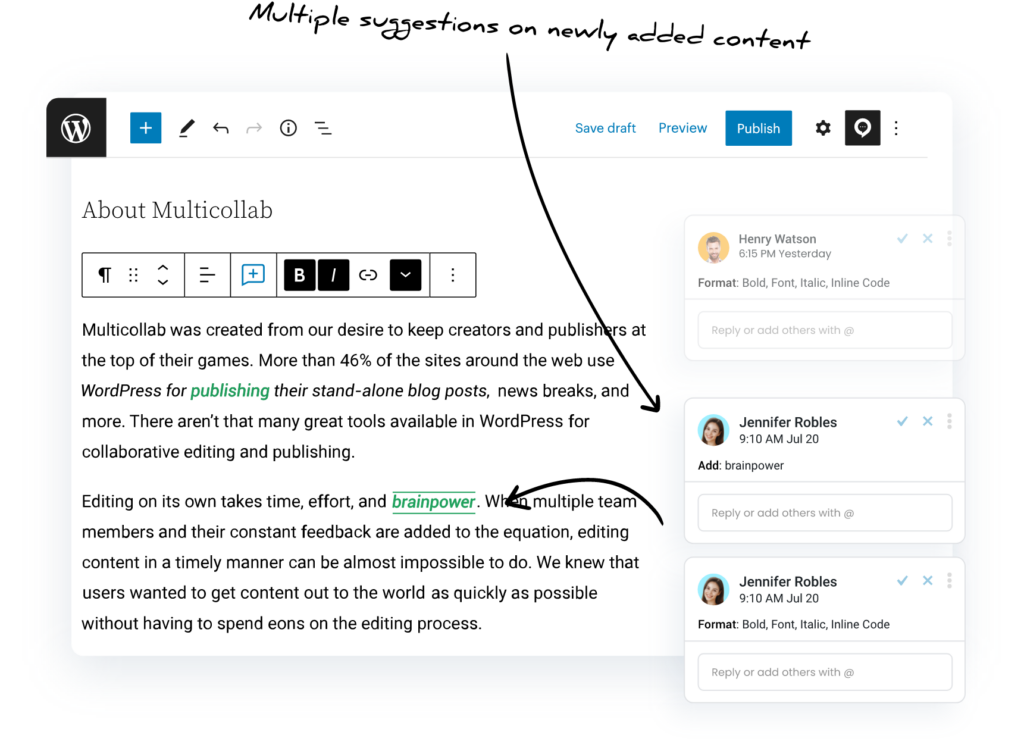
- Inline Comments: Allows users to add comments on any part of the content inside Block Editor.
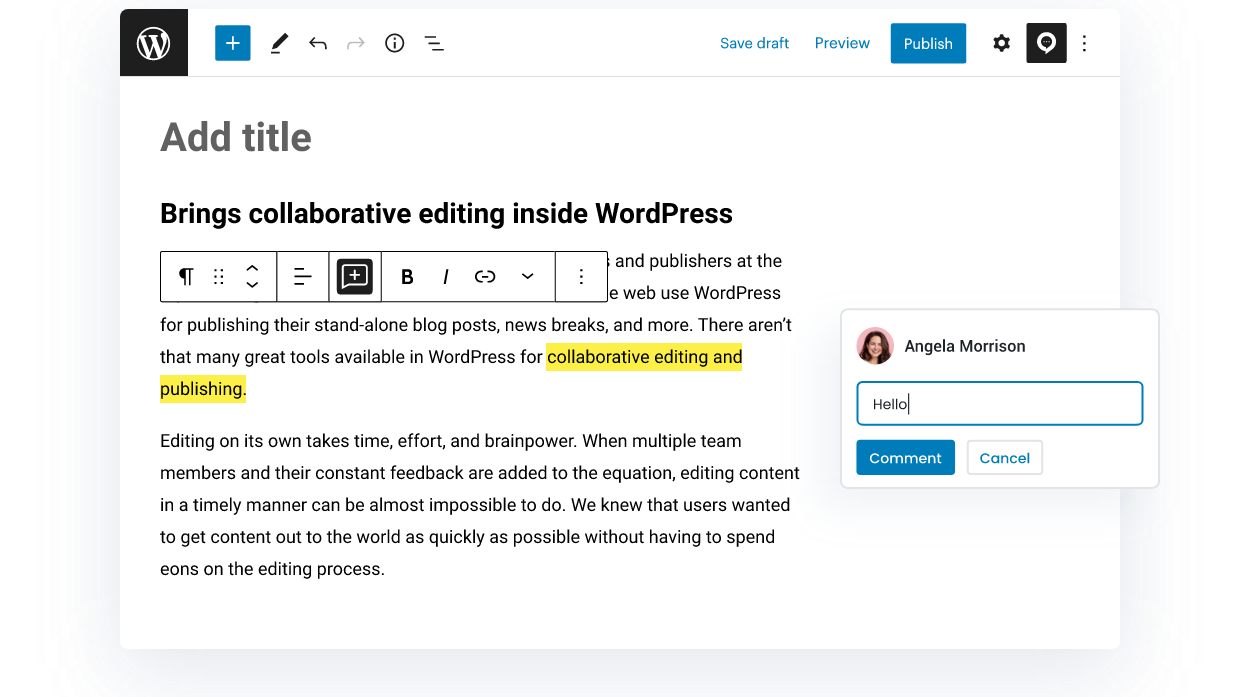
- Highlighted Edits: Highlights any edits made to posts or pages, making it easy to accept, reject, and collaborate on changes.
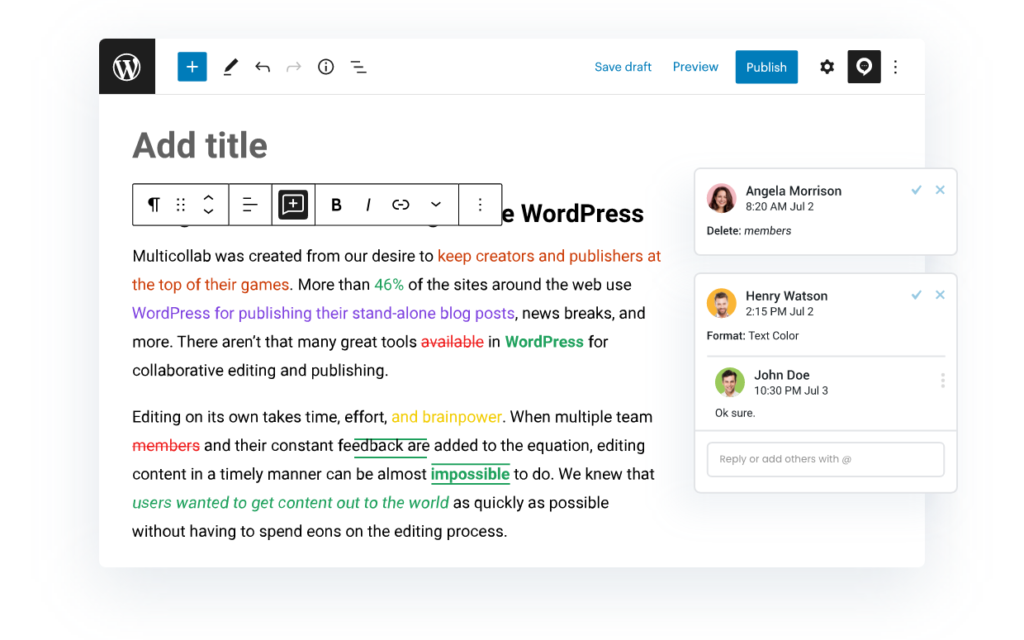
- Collaborative Reviews: Facilitates team collaboration and creative feedback during the publishing process.
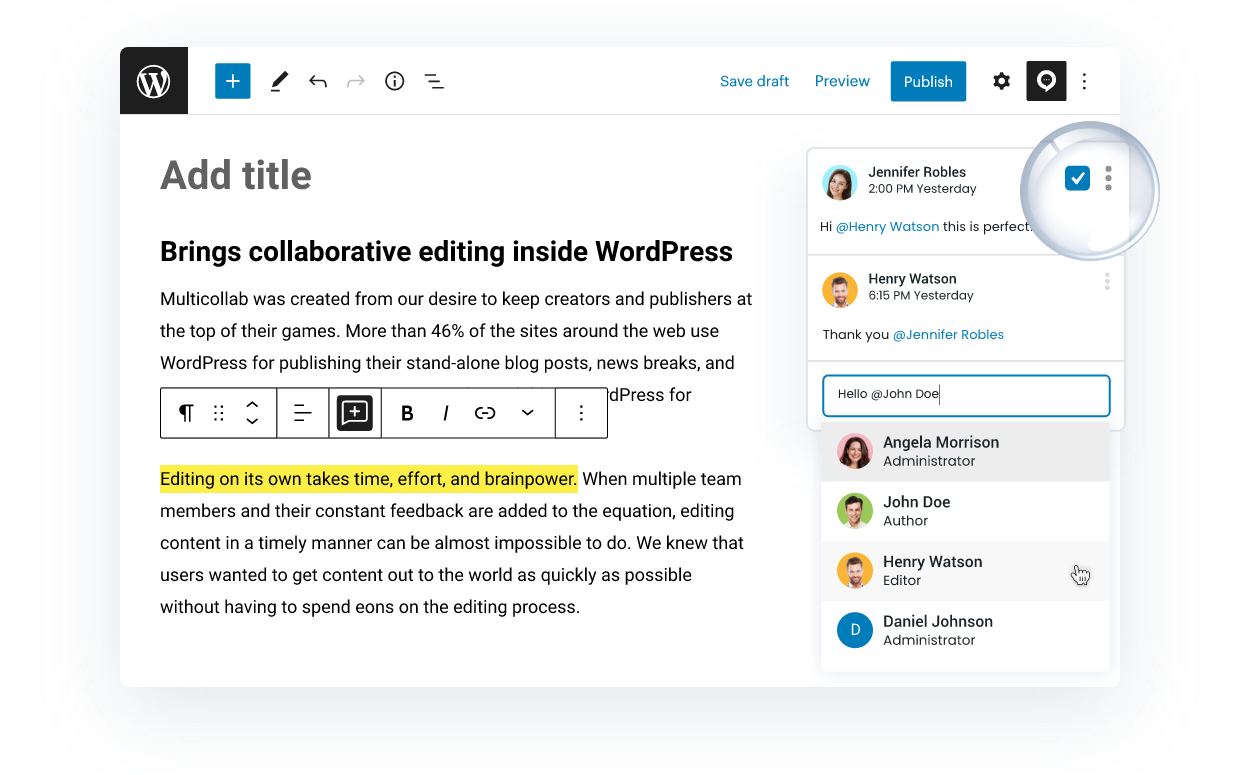
- Mentioning Users: Users can be invited to collaborate and comment on a post simply by mentioning them.
- Email Notifications: Users receive email notifications when they are mentioned, enabling quick participation in the conversation.
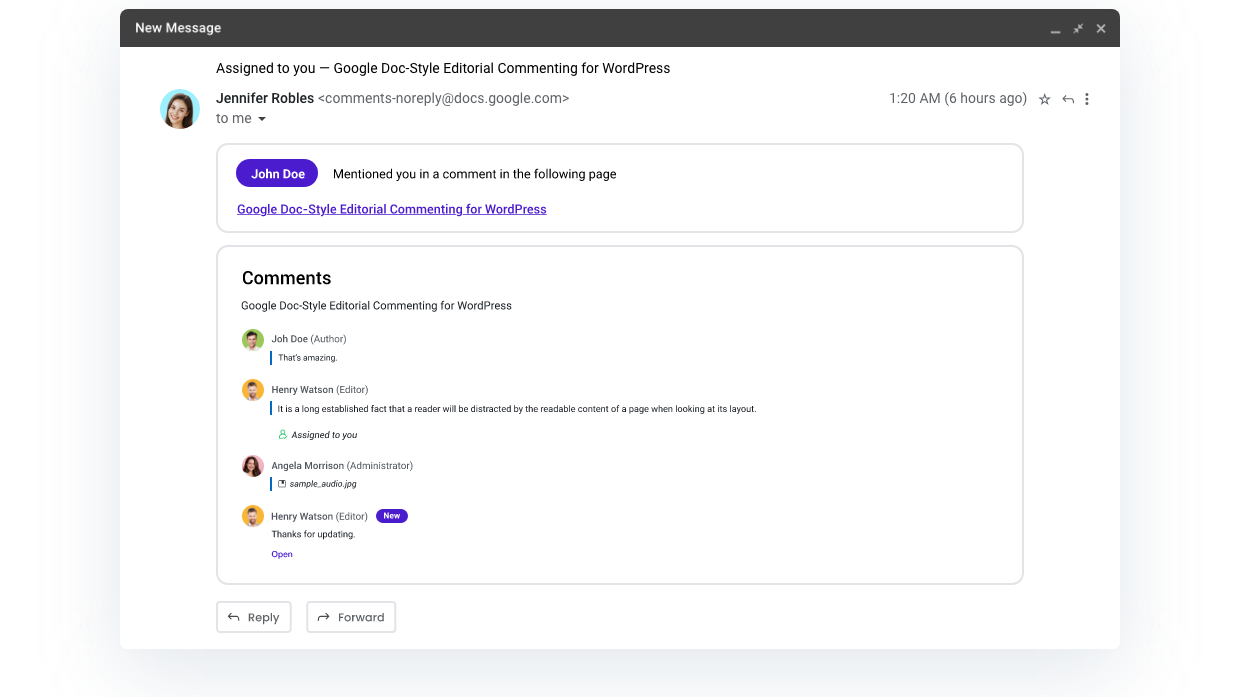
- Co-editing – Enjoy a real-time team document collaboration workspace allowing users to co-edit drafts collaboratively.
- Comment Anywhere – Add inline comments to any text or media in your blog post for review by others. You can select any text/media and add comments, just like in Google Docs.
- Email Notifications – Instant email notifications make collaborations with your team easier and foster intra-group connectivity.
- Add Attachments to Comments – Collaborators can attach images or documents to their comments and replies.
- Multilingual – You can use the Multicollab plugin in 6 distinct languages – German, Chinese, Hindi, Spanish, French, and Bengali.
- Custom Permissions – Decide which team members should have permission to manage comments and suggestions in Multicollab.
- Reports and Activities – Track progress across all pages and posts with easy filtering to view by user, content categories, and time stamps.
- Guest Collaboration – Invite guest collaborators over email with magic links without creating a WordPress user account.
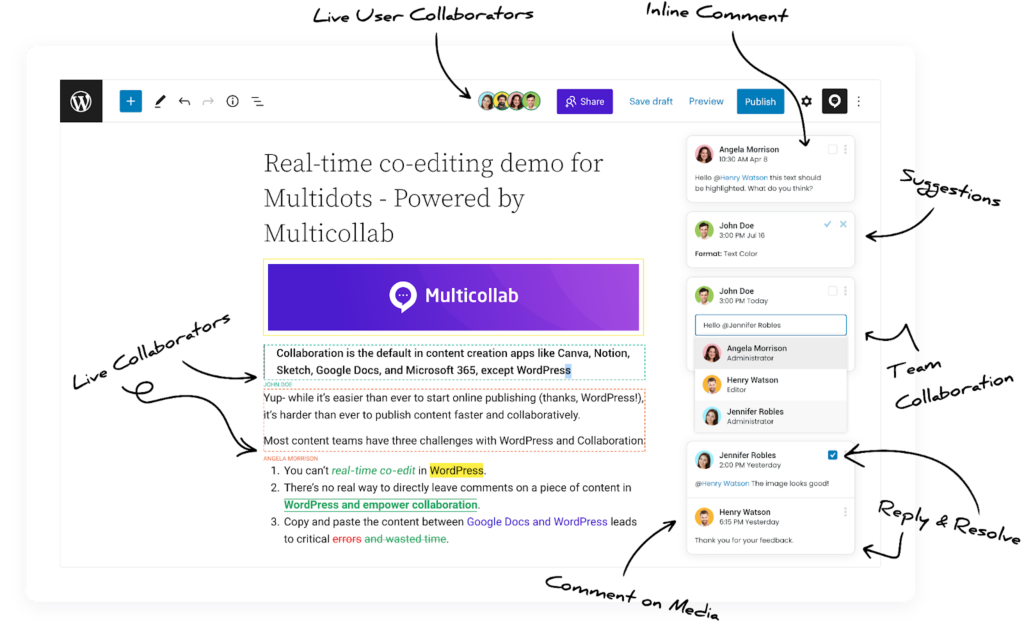
Why Choose Multicollab for Real-Time Collaboration in WordPress?
- Efficient Collaborative Editing: Allow multiple team members to engage in collaborative editing, ensuring that everyone is on the same page when crafting content.
- Enhanced Communication Tools: Facilitate seamless communication among entire teams, whether they’re in the same room or working remotely.
- Streamlined Publishing Workflow: Streamline the publishing workflow, enabling content managers to efficiently coordinate tasks and oversee the entire content creation process. Elevate your WordPress content production workflow to produce quality content faster.
- Optimized Site Editor Experience: With real-time collaboration feature, the WordPress site editor becomes a dynamic space where multiple people can work collaboratively, ensuring content accuracy and coherence.
- Facilitating Larger Teams: WordPress’s collaboration roadmap is designed to accommodate larger teams, ensuring that even with multiple users, data remains organized and accessible.
- Version Control for Consistency: Version control guarantees that everyone is working on the latest iteration of a document, maintaining consistency across content pieces.
- Utilizing Resources Efficiently: Maximize the efficient use of resources, as teams can collaborate on content pieces without duplicating efforts or facing data silos.
Take your team’s real-time collaboration to the next level, with Multicollab leading the way.
FAQs:
Real-time collaboration refers to the simultaneous collaboration of team members on a project, allowing instant communication, feedback, and modifications. Multicollab enables this by providing co-editing and inline commenting features directly within the WordPress editor.
A real-time collaboration example in content production is a writer and editor working on a blog post simultaneously in the WordPress editor with Multicollab. They can add, respond to, and resolve comments instantly, leading to faster content creation and improved quality.
Real-time collaboration fosters improved team communication, streamlined content production workflows, enhanced content quality, and increased team satisfaction and productivity. It also reduces the need for multiple revisions, enhancing the speed and efficiency of content production.








